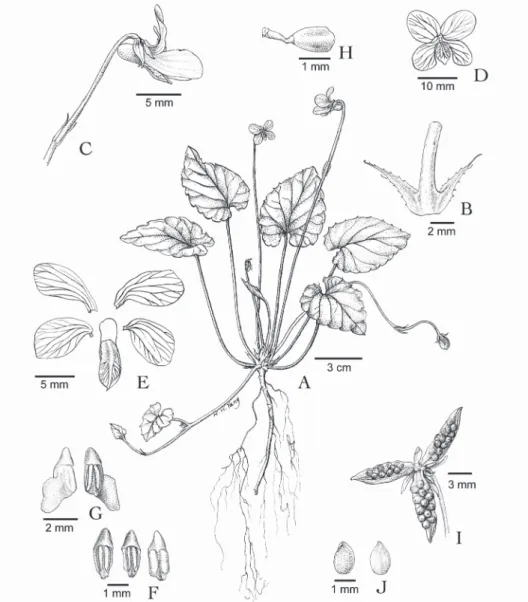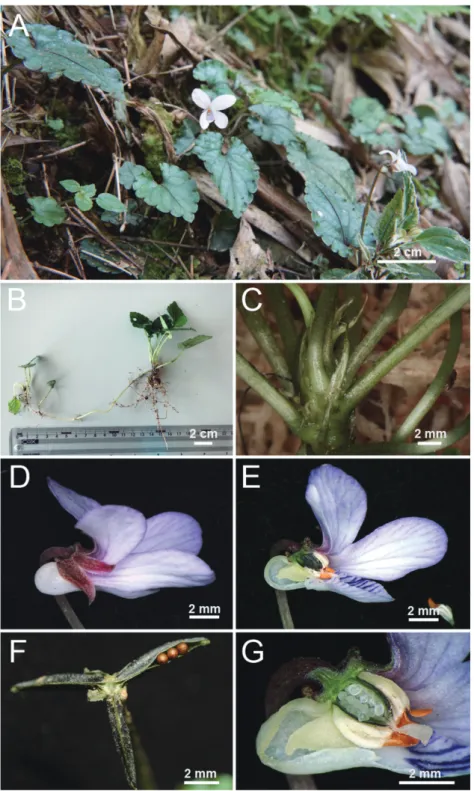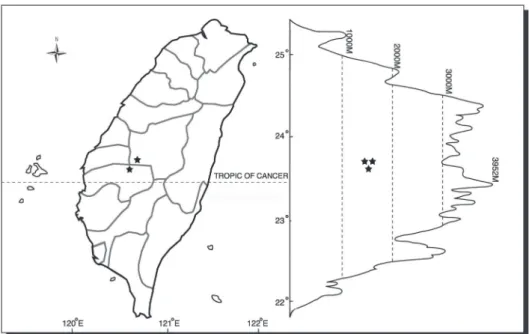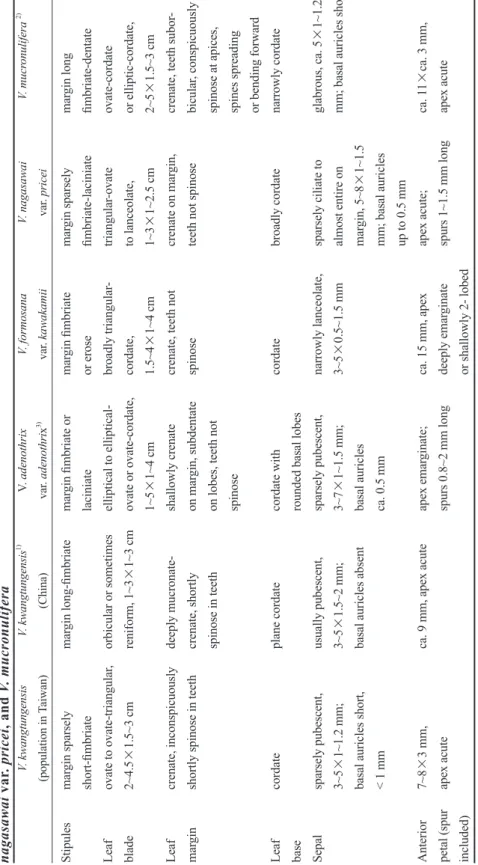Viola kwangtungensis Melch. (Violaceae):
a New Record Viola in Taiwan
Chang-Tse Lu,
1) Yu-Long Hung,
2) Chih-Hsiung Chen
3,4)
【 Summary】
In this paper, a new record Viola species of Taiwan, V. kwangtungensis Melch., is reported.
This newly recorded species was found at elevations of 1300~1600 m in Taiwan, growing in shady soil on a slope under a bamboo plantation. It is similar to V. mucronulifera Handel-Mazzetti and V. formosana Hayata var. kawakamii (Hayata) Chen & Yang, as well as V. adenothrix Hayata var.
adenothrix and V. nagasawae Makino & Hayata var. pricei (W. Becker) Wang & Huang. Detailed differences in diagnostic morphological features of these species are discussed in this paper.
Key words: new record species, Taiwan, Violaceae, Viola kwangtungensis.
Lu CT, Hung YL, Chen CH. 2019. Viola kwangtungensis Melch. (Violaceae): a new record Viola in Taiwan. Taiwan J For Sci 34(2):135-42.
1) Department of Biological Resources, National Chiayi University, 300 Syuefu Rd., Chiayi 60004,
Taiwan. 國立嘉義大學生物資源學系,60004嘉義市鹿寮里學府路300號。
2) Amateur nature observer, 188 Jincheng Street, Jindun Village, Huatan Township, Changhua 50343,
Taiwan. 生態攝影家,50343彰化縣花壇鎮金墩村金城街188號。
3) Department of Biology, National Museum of Natural Science, 1 Guancian Rd., Taichung 40453,
Taiwan. 國立自然科學博物館生物學組,40453台中市館前路1號。
4)Corresponding author, e-mail:alanchen@mail.nmns.edu.tw 通訊作者。
Received September 2018, Accepted May 2019. 2018年9月送審 2019年5月通過。
研究簡報
台灣堇菜科的新紀錄種—廣東堇菜
呂長澤
1) 洪裕榮
2) 陳志雄
3,4)
摘 要
為本文報導了台灣一新記錄種的堇菜-廣東堇菜 (Viola kwangtungensis Melch.)。這種新的
記錄物種分布於台灣海拔1300~1600 m山區,生長在竹林下的斜坡上。它近似於小尖堇菜 (V.
mucronulifera Handel-Mazzetti) 和川上氏堇菜 (V. formosana Hayata var. kawakamii (Hayata) Chen
& Yang) , 以及喜岩菫菜 (V. adenothrix Hayata var. adenothrix) 與普萊氏菫菜 (V. nagasawae Makino &
Hayata var. pricei (W. Becker) Wang & Huang)。在本文中,我們對這些物種在形態特徵上的詳細差
異進行討論。
關鍵詞:新紀錄種、台灣、堇菜科、廣東堇菜。
呂長澤、洪裕榮、陳志雄。2019。台灣堇菜科的新紀錄種—廣東堇菜。台灣林業科學34(2):135-42。
Viola Linnaeus (1753: 933) comprises approximately 600 species worldwide (Mar- cussen et al. 2015) and is the largest genus of the Violaceae (Wahlert et al. 2014). It is monophyletic and is thought to have diversi- fied ca. 30 Mya in South America (Ballard et al. 1999). Viola consists of at least 17 mono- phyletic lineages and putative sections (Fan et al. 2015) and is currently undergoing revi- sion (Marcussen et al. 2015). In East Asia, the genus is mostly distributed in temperate regions, and numerous new species have been described in recent years [such as V. austrosi- nensis (Chen and Yang 2008), V. maoersha- nensis, V. nitida (Chen and Yang 2009), V.
changii (Zhou and Xing 2007), V. nanlingen- sis (Zou et al. 2008), V. guangzhouensis (Dong et al. 2009), and V. jinggangshanensis (Ning et al. 2012)]. In total, 16~18 Viola species have been reported to occur in Taiwan (Wang and Huang 1990, 1993, Wang 1991, Yang et al. 2000, Chen et al. 2007).
Recently, according to our botanical fieldwork in central Taiwan, an unfamiliar
species of Viola was found by the second and third authors. This species was always found growing in shady soil on slopes under a bam- boo plantation. Taking into consideration the characteristics of the slender, elongated sto- lons with scattered leaves, rootlets emitting from nodes and internodes of stolons, and the acute apex of the lower petal, this unfamiliar species should belong to the Viola series Aus- tralasiaticae Okamoto (Okamoto et al. 1993).
Subsequent observations and a litera- ture survey were carried out. Eventually we confirmed this species to be V. kwangtun- gensis Melch., a species endemic to China (Chen et al. 2007). And now we report it as a newly recorded species in Taiwan.
Diagnostic morphological characteristics
of this new record species were compared
to those of congeners found in Taiwan and
neighboring areas, and are summarized in a
table. Additionally, distribution maps, and
a discussion of this new record species and
similar taxa in Taiwan and neighboring ar-
eas are provided.
Table 1. Morphological comparison of V iola kwangtungensis with V. adenothrix var . adenothrix , V . formosana var . kawakamii , V. nagasawai var . pricei , and V. mucronulifera
V. kwangtungensisV. kwangtungensis1) V.
adenothrixV. formosanaV. nagasawaiV. mucronulifera2) (population in Taiwan)(China)var
. adenothrix
3)var
. kawakamiivar
. pricei Stipulesmargin sparselymargin long-fimbriatemargin fimbriate ormargin fimbriatemargin sparselymargin long short-fimbriatelaciniateor erosefimbriate-laciniatefimbriate-dentate Leaf ovate to ovate-triangular, orbicular or sometimeselliptical to elliptical-broadly triangular- triangular-ovateovate-cordate blade2~4.5×1.5~3 cmreniform, 1~3×1~3 cmovate or ovate-cordate,cordate,to lanceolate,or elliptic-cordate, 1~5×1~4 cm1.5~4×1~4 cm1~3×1~2.5 cm2~5×1.5~3 cm Leafcrenate, inconspicuouslydeeply mucronate-shallowly crenatecrenate, teeth notcrenate on margin,crenate, teeth subor- marginshortly spinose in teethcrenate, shortlyon margin, subdentatespinoseteeth not spinosebicular, conspicuously spinose in teethon lobes, teeth notspinose at apices, spinosespines spreading or bending forward Leafcordateplane cordatecordate with cordatebroadly cordatenarrowly cordate baserounded basal lobes Sepalsparsely pubescent,usually pubescent,sparsely pubescent,narrowly lanceolate,sparsely ciliate toglabrous, ca. 5×1~1.2 3~5×1~1.2 mm;3~5×1.5~2 mm;3~7×1~1.5 mm;3~5×0.5~1.5 mmalmost entire onmm; basal auricles short basal auricles short,basal auricles absentbasal auricles margin, 5~8×1~1.5 < 1 mmca. 0.5 mmmm; basal auricles up to 0.5 mm Anterior7~8×3 mm,ca. 9 mm, apex acuteapex emarginate;ca. 15 mm, apexapex acute;ca. 11×ca. 3 mm, petal (spur apex acutespurs 0.8~2 mm longdeeply emarginate spurs 1~1.5 mm longapex acute included)or shallowly 2- lobed
1) Description based on Melchior (1933) and Chen et al. (2007);
2) Description based on Chen et al. (2007);
3) Description based on Wang and Huang (1993).



